-

新人教版高中英语必修3Unit 3 Diverse Cultures教学设计三
The price is the same as(the price was)before the war.价格与战前相同。(4)定语从句中的“关系代词+助动词be”可以省略。The ticket(that/which was)booked by his sister has been sent to him.他妹妹订的那张票已送到了他那里。Step 5 PracticeActivity 3(1) Guide students to complete the four activities in the Using Structures part of exercise book, in which activities 1 and 2 focus on ellipsis in dialogue answers, activity 3 focus on signs and headlines, two typical situations where ellipsis is used, and activity 4 focus on ellipsis in diary, an informal style.(2) Combine the examples in the above activities, ask students to summarize the omitted situations in groups, and make their own summary into a poster, and post it on the class wall after class to share with the class.(This step should give full play to the subjectivity of students, and teachers should encourage students to conclude different ellipsis phenomena according to their own understanding, they can conclude according to the different parts omitted in the sentence.)Step 6 Homework1. Understand and master the usages of ellipsis;2. Finish the other exercises in Using structures of Workbook.1、通过本节内容学习,学生是否理解和掌握省略的用法;2、通过本节内容学习,学生能否根据上下文语境或情景恢复句子中省略的成分,体会使用省略的效果;3、通过本节内容学习,学生能否独立完成练习册和导学案中的相关练习。
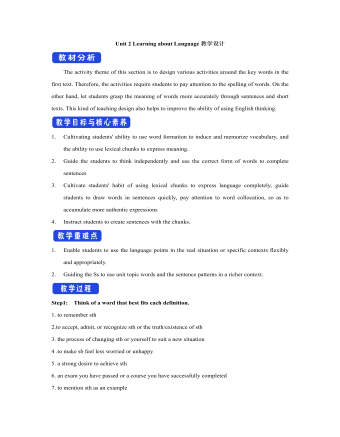
新人教版高中英语选修2Unit 2 Learning about Language教学设计
The activity theme of this section is to design various activities around the key words in the first text. Therefore, the activities require students to pay attention to the spelling of words. On the other hand, let students grasp the meaning of words more accurately through sentences and short texts. This kind of teaching design also helps to improve the ability of using English thinking.1. Cultivating students' ability to use word formation to induce and memorize vocabulary, and the ability to use lexical chunks to express meaning.2. Guide the students to think independently and use the correct form of words to complete sentences3. Cultivate students' habit of using lexical chunks to express language completely, guide students to draw words in sentences quickly, pay attention to word collocation, so as to accumulate more authentic expressions4. Instruct students to create sentences with the chunks.1. Enable students to use the language points in the real situation or specific contexts flexibly and appropriately.2. Guiding the Ss to use unit topic words and the sentence patterns in a richer context.Step1: Think of a word that best fits each definition.1. to remember sth2.to accept, admit, or recognize sth or the truth/existence of sth3. the process of changing sth or yourself to suit a new situation4 .to make sb feel less worried or unhappy5. a strong desire to achieve sth
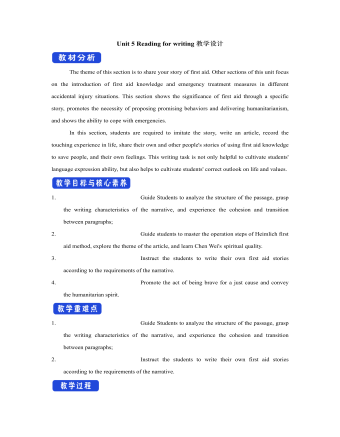
新人教版高中英语选修2Unit 5 Reading for writing教学设计
你校英语报计划出版一期急救常识专刊,现面向全校学生公开征集稿件,你有意参加。请你根据下面提示内容,用英语写一篇短文,介绍在车祸现场对伤者进行急救的方法和步骤。1.确保现场的安全;2.询问伤者,确保其呼吸正常;3.检查伤口,如流血则应采取止血措施;4.如需急救,确保其处于康复位置。注意:1.词数80左右;2.可以适当增加细节,以使行文连贯。参考词汇:康复位置 recovery positionAs we all know, having a knowledge of first aid can make a great difference in our daily life. If a traffic accident happens and someone is injured, the following steps can be used to treat the injured.In the first place, we should make sure that the accident scene is safe so that we won’t get hurt. We should ask the injured person if he is OK, and see if he is breathing. What’s more, we should check for cuts and wounds. If he is bleeding badly, it is vital that we should try to stop the bleeding by applying pressure to the injury. This is because if a person loses too much blood, he may die. If necessary, take the injured person to the hospital as soon as possible.Do remember: when giving first aid, please be sure to place the person in a recovery position.
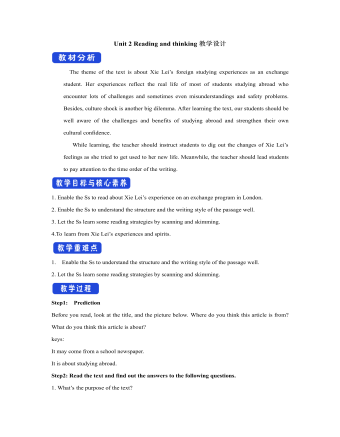
新人教版高中英语选修2Unit 2 Reading and thinking教学设计
Her tutor told her to acknowledge __________ other people had said if she cited their ideas, and advised her _______(read) lots of information in order to form __________wise opinion of her own.Now halfway __________ her exchange year, Xie Lei felt much more at home in the UK. She said __________ (engage) in British culture had helped and that she had been__________ (involve) in social activities. She also said while learning about business, she was acting as a cultural messenger __________(build) a bridge between the two countries. keys:Xie Lei, a 19yearold Chinese student, said goodbye to her family and friends in China and boarded (board) a plane for London six months ago in order to get a business qualification. She was ambitious(ambition) to set up a business after graduation. It was the first time that she had left (leave) home.At first, Xie Lei had to adapt to life in a different country. She chose to live with a host family, who can help with her adaptation (adapt) to the new culture. When she missed home, she felt comforted (comfort) to have a second family. Also Xie Lei had to satisfy academic requirements. Her tutor told her to acknowledge what other people had said if she cited their ideas, and advised her to read lots of information in order to form a wise opinion of her own.Now halfway through her exchange year, Xie Lei felt much more at home in the UK. She said engaging (engage) in British culture had helped and that she had been involved (involve) in social activities. She also said while learning about business, she was acting as a cultural messenger building a bridge between the two countries.
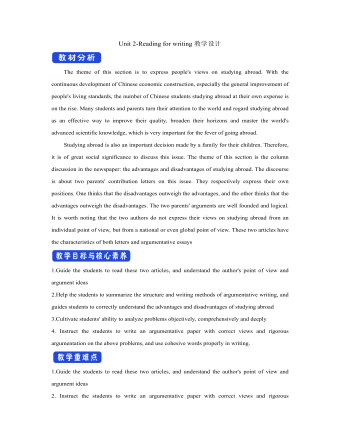
新人教版高中英语选修2Unit 2 Reading for writing教学设计
The theme of this section is to express people's views on studying abroad. With the continuous development of Chinese economic construction, especially the general improvement of people's living standards, the number of Chinese students studying abroad at their own expense is on the rise. Many students and parents turn their attention to the world and regard studying abroad as an effective way to improve their quality, broaden their horizons and master the world's advanced scientific knowledge, which is very important for the fever of going abroad. Studying abroad is also an important decision made by a family for their children. Therefore, it is of great social significance to discuss this issue. The theme of this section is the column discussion in the newspaper: the advantages and disadvantages of studying abroad. The discourse is about two parents' contribution letters on this issue. They respectively express their own positions. One thinks that the disadvantages outweigh the advantages, and the other thinks that the advantages outweigh the disadvantages. The two parents' arguments are well founded and logical. It is worth noting that the two authors do not express their views on studying abroad from an individual point of view, but from a national or even global point of view. These two articles have the characteristics of both letters and argumentative essays1.Guide the students to read these two articles, and understand the author's point of view and argument ideas2.Help the students to summarize the structure and writing methods of argumentative writing, and guides students to correctly understand the advantages and disadvantages of studying abroad3.Cultivate students' ability to analyze problems objectively, comprehensively and deeply
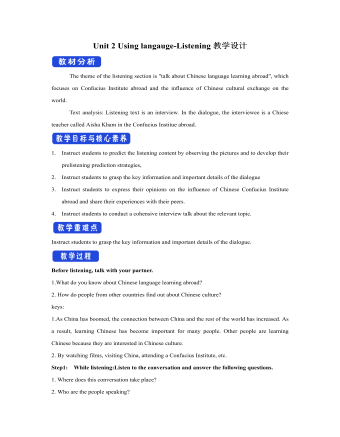
新人教版高中英语选修2Unit 2 Using langauge-Listening教学设计
? B: Absolutely! Getting involved with Chinese cultural activities there definitely helped a lot. I got to practice my Chinese on a daily basis, and I could learn how native Chinese speakers spoke.? A: What do you feel is your biggest achievement?? B: Learning Chinese characters! I have learnt about 1,500 so far. When I first started, I didn't think it was even going to be possible to learn so many, but now I find that I can read signs, menus, and even some easy newspaper articles.? A: What are you most keen on?? B: I've really become keen on learning more about the Chinese culture, in particular Chinese calligraphy. As I have learnt Chinese characters, I have developed a great appreciation for their meaning. I want to explore Chinese characters by learning how to write them in a more beautiful way. ? A: Finally, what do you want to say to anyone interested in learning Chinese?? I have really become keen on learning more about the Chinese culture, in particular Chinese Calligraphy. As I have learnt Chinese character, I have developed a great appreciation for their meaning. I want to explore Chinese characters by learning how to write them in a more beautiful way.? A: Finally, what do you want to say to anyone interested in learning Chinese?? B: I'd say, give it a shot! While some aspects may be difficult, it is quite rewarding and you will be happy that you tried.? A: Thanks for your time. ? B:You're welcome.

新人教版高中英语选修2Unit 4 Reading for writing教学设计
假定你是英国的Jack,打算来中国旅行,请你给你的中国笔友李华写一封信,要点如下:1.你的旅行计划:北京→泰山→杭州;2.征求建议并询问他是否愿意充当你的导游。注意:1.词数80左右(开头和结尾已给出,不计入总词数);2.可以适当增加细节,以使行文连贯。参考词汇:故宫 the Forbidden City;泰山 Mount TaiDear Li Hua,I'm glad to tell you that 'm going to visit China.First,I am planning to visit Beijing,the capitalof China,where I am looking forward to enjoying the Great Wall,the Forbidden City and somebeautiful parks.Then I intend to go to visit Mount Tai in Shandong Province.I've heard that it is one ofthe most famous mountains in China and I can't wait to enjoy the amazing sunrise there.After that,I amalso going to Hangzhou.It is said that it is a beautiful modern city with breathtaking natural sights,among which the West Lake is a well- known tourist attraction.What do you think of my travel plan? Will you act as my guide? Hope to hear from you soon.

新人教版高中英语选修2Unit 4 Using langauge-Listening教学设计
The theme of the listening section is " talking about scenery and culture along a journey."The part is designed to further lead the students to understand Canadian natural geography and social environment, and integrated into the cultural contrast by mentioning the long train journey from Beijing to Moscow routes. On this basis, the part activates students related travel experience, lets the student serial dialogue, guides the student to explore further the pleasure and meaning of the long journey, and Chinese and foreign cultural comparison.The part also provides a framework for the continuation of the dialogue, which is designed to provide a framework for students to successfully complete their oral expressions, and to incorporate an important trading strategy to end the dialogue naturally.1. Help students to understand and master some common English idioms in the context, and experience the expression effect of English idioms.2. Guide the students to understand the identity of different people in the listening context, and finish the dialogue according to their own experience.3. Instruct the students to use appropriate language to express surprise and curiosity about space and place in the dialogue, and master the oral strategy of ending the dialogue naturally.1. Instruct students to grasp the key information and important details of the dialogue.2. Instruct students to conduct a similar talk on the relevant topic.

新人教版高中英语选修2Unit 5 Using langauge-Listening教学设计
The theme of this section is to learn how to make emergency calls. Students should learn how to make emergency calls not only in China, but also in foreign countries in English, so that they can be prepared for future situations outside the home.The emergency telephone number is a vital hotline, which should be the most clear, rapid and effective communication with the acute operator.This section helps students to understand the emergency calls in some countries and the precautions for making emergency calls. Through the study of this section, students can accumulate common expressions and sentence patterns in this context. 1.Help students accumulate emergency telephone numbers in different countries and learn more about first aid2.Guide the students to understand the contents and instructions of the telephone, grasp the characteristics of the emergency telephone and the requirements of the emergency telephone.3.Guide students to understand the first aid instructions of the operators.4.Enable Ss to make simulated emergency calls with their partners in the language they have learned1. Instruct students to grasp the key information and important details of the dialogue.2. Instruct students to conduct a similar talk on the relevant topic.Step1:Look and discuss:Match the pictures below to the medical emergencies, and then discuss the questions in groups.
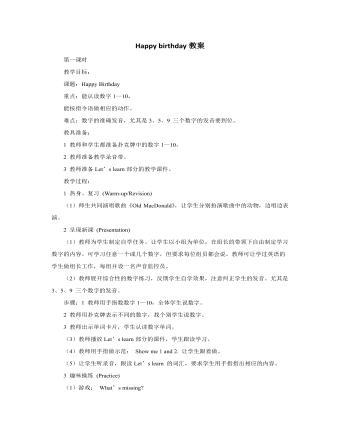
人教版新课标PEP小学英语三年级上册Happy birthday教案
(2)猜猜看每次请一个同学在黑板上画一种刚学到的物品,他每画一笔,就请班上的同学用英语猜他画的是什么。如猜得正确,就请下一位同学再重新开始画另一种物品。(3)Let’s rhyme.将所学的单词替换第一单元的Let’s chant中的文具。教师将全班分为两大组,教师举图片提示,如第一组说:I have a balloon.第二组一起说:Me too. 拍手,举第二幅图时两组交换。以此类推。(4)教师将单词的图片先面朝上贴在黑板上,给学生20秒时间记住这些单词,然后每张图卡用1张彩色纸盖上。学生要先说出彩色纸的颜色,再说出下面卡上的词。待学生熟悉后,可加大游戏难度,将盖着彩色纸的图卡在(黑板上)打乱,进行游戏。(5)让学生听录音,边说边做Let’s do部分的活动。(6)教师将Let’s do中的图卡打乱顺序,贴在黑板上,教师说一个指令,请学生指出正确的图片。正确的可为本组赢一分。
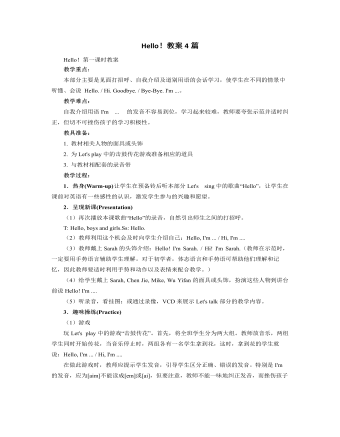
人教版新课标PEP小学英语三年级上册Hello!教案4篇
(3)通过游戏Simon says 来练习以show, open, close, put, carry 所引导的祈使句。教师发指令学生做动作。但只有听到老师带有Simon says的指令时,才能做出相应的动作,否则就是失败。失败的同学退出游戏。(4)听Let's chant的录音,学生边听边做,逐渐过渡成边听边说边做,最后独立说做,并进行比赛。4. 课堂评价(Assessment)做活动手册本单元第5部分练习。学生根据录音,圈出所听到的文具。具体方法和步骤参考如下:(1)学生看图,用英语说出图中每样文具物品。(2)教师讲解题目的意思并指导做的方法。(3)学生听录音做练习。(4)再放录音,在教师的指导下让学生一句一句地跟读并互相核对答案,并说出所圈的文具,再通过给花朵涂色进行自我评价。5. 扩展性活动(Extensive activities)选词游戏。将学生分为六组,每组各派一个选手,教师说单词,选手快步跑到讲台前,找到所说单词,并举起大声读出,正确为胜。
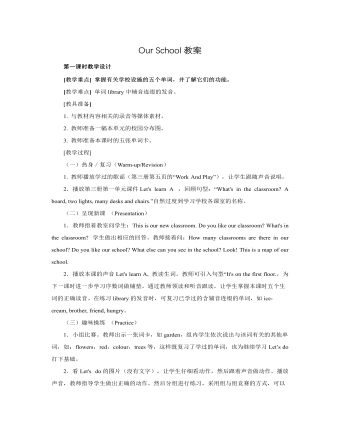
人教版新课标PEP小学英语四年级下册Our School教案
教学重点:Read and write 中的四个四会单词以及问句“Is this a teacher’s desk?”及其答句“Yes, it is.”在四线格中的正确书写。教学难点:拼读单词picture,在四线格中书写句型“Is this a …?”以及总结元音字母a的发音规则。教具准备:1.与教材内容相关的课件、声音、图片等媒体素材。2.教师准备相关的词卡。3.学生准备白纸和彩笔。教学过程(35sk. c om整理):(一)热身/复习(Warm-up/Revision)1.师生合唱该单元的歌曲和歌谣,边歌边舞。2.请学生表演Story time中的对话。3.猜谜语:教师给学生出一些简单的谜语,如:Jack is in a room. There are many books in it. He can see many students. They are reading books. They are quiet. Where is Jack?(二)呈现新课 (Presentation)1.请学生观察Read and write部分的情景图,预先空出来需要书写的四会单词,让学生独立思考,填充对话。
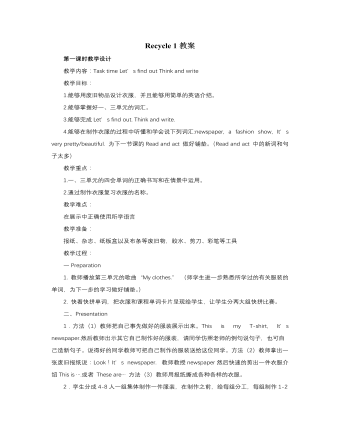
人教版新课标PEP小学英语四年级下册Recycle 1教案
1.Think and write接上一个环节,老师说“Zoom is careless. Where are his things? Let’s look.” 让学生看课本图片,认真观察。a. 教师给出例句,请同学仿照例句说出句子Zoom’s red shoes are in the library.Zoom’s green sweater is in the gym.b.学生完成课本图片后的短文。可以找程度好的同学在黑板上书写。c.让学生在小组内朗读句子。2. Let’s read..出示钟表模型,老师拨出几个有代表性的时间,学生分两组用“What time is it ? It’s ........It’s time to ……”进行问答。老师在学生回答时把时间和活动写在黑板上如下:Time Activities7:00 get up 7:30 go to school9:00have Chinese/math class10:00read books 或其他12:00 eat lunch3:15have P.E classOh, you have a busy day. Look, this is John’s day.a. 由上个环节引出John’s list. 教师引导学生仔细看Let’s read 部分的图,阅读John的活动时间表, 然后独立完成句子的正误判断,最后进行检查。b.让学生再次读John的活动时间表,回答下面的问题:What time does John go to school? Where does John read books?
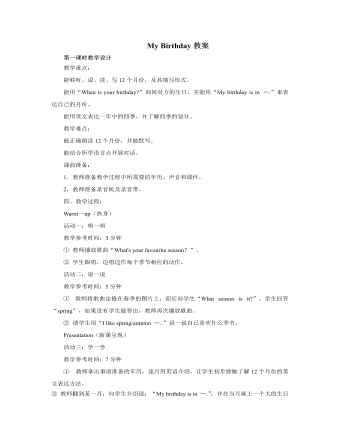
人教版新课标PEP小学英语五年级下册My Birthday教案
① 教师询问学生“What day is today?”,学生说出“Today is …”。而后又问学生:“What’s the date?”,帮助学生说出今天的具体日期:“It’s …”。 ② 让学生拿出课前准备的年历(最好是学生自己制作的),教师随意指着某天询问学生:“What’s the date?”,而后请学生拿着年历相互用“What’s the date? It’s ….”进行问答练习。③ 教师拿着年历从一月开始问学生:“Who has a birthday in January? Please stand up.”,而后教师问起立的学生:“What’s the date?”,让一月份生日的学生答出具体日期。④ 请若干名学生代替老师进行提问,从二月到十二月。活动四:Let’s talk教学参考时间:8分钟① 教师播放对话录音两遍,而后提问:“When is Sarah’s birthday? When is Zhang’s birthday?”,学生根据对话内容回答出:“Sarah’s birthday is in October1st. Zhang’s birthday’s is in March12th.”。 ② 学生跟读对话,两人一组做对话练习。 ③ 学生根据同学的生日组织一个新的对话,教师请若干组展示他们的对话。
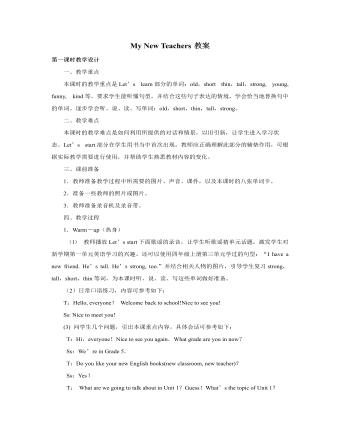
人教版新课标PEP小学英语五年级上册My New Teachers教案
教师播放Let’s learn课件,提问:Guess, what does Wu Yifan do on Saturdays? 请3-4人回答后。用同样方法完成watch TV, read books,请学生听并且跟读。继续看课件,播放两个男孩的对话,请学生听并跟读,注意语音、语调。 在句子中练习单词,培养学生的表达能力。对话练习听录音中的对话 1-2遍,请同学说一说对话的内容。可选择自己喜欢的角色进行人机对话。分组练习,向你的朋友询问。培养学生的模仿力,并能在恰当情境中灵活运用所学句型。Let’s chant B出示B部分的歌谣,请学生小声试读,可以读出不同的节奏。播放歌谣,请学生仔细倾听2-3遍,说到相对应的地方,教师带领学生指一指画画、看电视、读书、玩电脑游戏这四种情景,帮助学生理解歌谣。请学生反复跟读。分角色演唱,可拍手掌握节奏。 看一看、说一说帮助学生巩固本课句型。转盘游戏教师拿出课前制作好的大转盘,上面有do homework, watch TV, read books这三幅图画。请一名学生拨动转盘,转盘快速转动,停止时看指针指向哪一幅图,该生提问What do you do on Sundays?其余同学回答,先回答出的同学可拨动转盘,游戏继续。
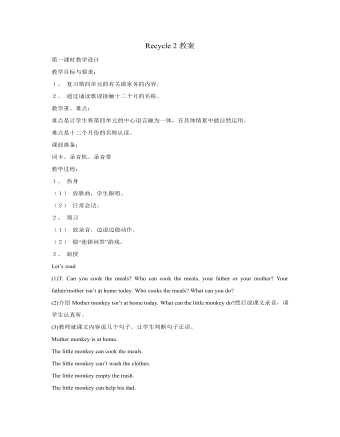
人教版新课标PEP小学英语五年级上册Recycle2教案
教学目标与要求:1、 通过活动和复习句型,介绍及动作短语等。2、 学唱歌曲。教学重、难点:重点为复习巩固介词及存在句型。难点为正确区分内容相近的图片。课前准备:词卡、录音机、录音带、图片教学过程:1、 热身(1) 放歌曲录音,学生跟唱。(2) 师生进行日常会话。2、 预习做“按我说的做”游戏。3、 新授(1) 看图片,问:Where is the …? Ss: It’s in /on/over…(2) 做“猜一猜”游戏。(3) 两人一组完成Pair work,连一连,说一说。(4) 听录音,完成练习。录音原文如下:There are mountains behind her village. There is a river near her house. There is a new air-conditioner in her bedroom. She cleans her bedroom every day.There is a lake near his village. There are many trees in front of his house. There is a big trash bin in his kitchen. He can cook tasty meals.There is a forest near his village. There is a road beside his house. There is a man under a tree. He often waters the flowers.There are many Paths in her village. There are new curtains on the window of her house. There are many new skirts in her closet. She washes the clothes every weekend.巩固延伸:做“幸运摸奖”游戏
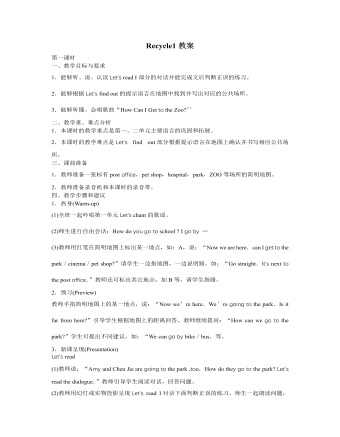
人教版新课标PEP小学英语六年级上册Recycle1教案
1.热身(warm-up) (1)全班齐唱歌曲“How call I Get to the Zoo?’’ (2)师生一起吟唱第一单元的歌谣,要求学生一边吟唱,一边用手打节拍。 2.预习(Preview) 教师对学生有关My Dream Vacation的短文做出总体评价,并请几名写得有创意的学生朗读他们的短文,教师针对其内容提问,如:“Where are you going? What are you going to do? How are you going to there等。教师根据课前的准备,在最后一名学生朗读完文章并回答了问题以后,简化并板书该学生的回答,将其改编成为一首小歌谣,如: Where are you going? What are you going to do? I’m going to the ZOO to see the monkeys. I’m going by bike.I’m going On foot. I live near the ZOO.So I won’t take a train. 教师拍节拍示范朗读自己改写的新歌谣,学生模仿吟唱新歌谣。 3.新课呈现(Presentation) Let’s chant 在以上活动的基础上,教师放Let’s chant部分的录音,学生静听并试着跟读,再看着文字吟唱。师生可进行问答式吟唱,并在小组间展开比赛。 Listen and match

新人教版高中英语必修3Unit 2 Morals and Virtues教学设计二
Activity 41. Students complete the task of activity 4, then teachers and students check the answers. 2. The teacher organized the students to work together and asked them to use the tables and mind maps sorted out before to retold the important choices in Lin Qiaozhi's life and their resultsStep 5 Language points1. The teacher asks the students to read the text carefully, find out the core words and long and difficult sentences in the text and draw lines, understand the use of vocabulary, and analyze the structure of long and difficult sentences. 2. The teacher explains and summarizes the usage of core vocabulary and asks the students to take notes. 3. The teacher analyzes and explains the long and difficult sentences that the students don't understand, so that the students can understand them better. Step 6 Homework1. Read the text again, in-depth understanding of the text; 2. Master the use of core vocabulary and understand the long and difficult sentences. 3. Complete relevant exercises in the guide plan. 1、通过本节内容学习,学生是否理解和掌握阅读文本中的新词汇的意义与用法;2、通过本节内容学习,学生能否结合文本特点总结林巧稚的人生原则和人格品质特征;3、通过本节内容学习,学生能否针对人生抉择发表自己的看法;能否全面地、客观地、理性地看待问题,进而对道德和人性有更加深入的思考和理解。

新人教版高中英语必修3Unit 2 Morals and virtues教学设计一
(2) students are divided into groups according to the requirements of activity 3. Each student shares a story of personal experience or hearing-witnessing kindness, and then selects the most touching story in the group and shares it with the whole class. Before the students share the story, the teacher can instruct them to use the words and sentence patterns in the box to express. For example, the words in the box can be classified:Time order: first of all, then, after that, later, finally logical relationship :so, however, although, butTeachers can also appropriately add some transitional language to enrich students' expression:Afterwards, afterwards, at last, in the end, eventuallySpatial order: next to, far from, on the left, in front ofOtherwise, nevertheless, as a result, therefore, furthermore, in addition, as well asSummary: in a word, in short, on the whole, to sum up, in briefStep 8 Homework1. Understand the definition of "moral dilemma" and establish a correct moral view;2. Accumulate vocabulary about attitudes and emotions in listening texts and use them to express your own views;3. Complete relevant exercises in the guide plan.1、通过本节内容学习,学生能否理解理解“道德困境”的定义;2、通过本节内容学习,学生能否通过说话人所表达的内容、说话的语气、语调等来判断其态度和情绪;3、通过本节内容学习,学生能否针对具体的道德困境发表自己的看法和见解,能否掌握听力理训练中的听力策略。

新人教版高中英语必修3Unit 3 Diverse Cultures教学设计二
(2)Consolidate key vocabulary.Ask the students to complete the exercises of activity 6 by themselves. Then ask them to check the answers with their partners.(The first language:Damage of the 1906 San Francisco earthquake and fire.A second language: Yunnan - one of the most diverse provinces in China).Step 5 Language points1. The teacher asks the students to read the text carefully, find out the more words and long and difficult sentences in the text and draw lines, understand the use of vocabulary, and analyze the structure of long and difficult sentences.2. The teacher explains and summarizes the usage of core vocabulary and asks the students to take notes.3. The teacher analyzes and explains the long and difficult sentences that the students don't understand, so that the students can understand them better.Step 6 Homework1. Read the text again, in-depth understanding of the text;2. Master the use of core vocabulary and understand the long and difficult sentences.3. Complete relevant exercises in the guide plan.1、通过本节内容学习,学生是否理解和掌握阅读文本中的新词汇的意义与用法;2、通过本节内容学习,学生能否结合文本特点了解文章的结构和作者的写作逻辑;3、通过本节内容学习,学生能否了解旧金山的城市风貌、文化特色,以及加利福尼亚州的历史,体会多元文化对美国的影响。